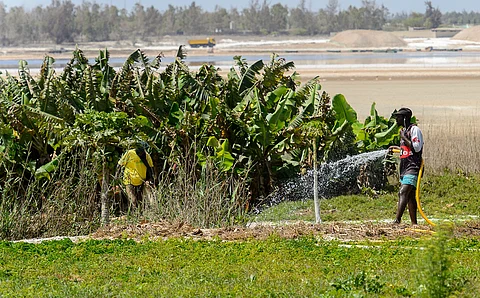

An innovative sustainable agricultural intensification approach in Senegal can enhance food security and land conservation through strategic crop choices in the West African country, according to a new study conducted by researchers at the International Food Policy Research Institute (IFPRI).
The sustainable agricultural intensification approach not only explores ways to improve farmers’ incomes but also mitigates potential environmental loss associated with extensive cropland expansion under current trends, according to the study published in the Journal of Cleaner Production.
Farmers’ land-use decisions can be guided by the relative risks and returns of different crops—similar to how financial investments are managed, the study noted.
It applied an optimal portfolio analysis to cropland allocation, aiming to enhance farming efficiency by considering market interconnections across sectors.
The analysis also offered a novel contribution by combining a methodological innovation with a unique analysis to advance the goal of Sustainable Intensification (SI).
The researchers claimed the study to be the first to explore transformational SI through an optimal cropland portfolio allocation evaluated within an economy wide system framework.
Using Senegal as a case study, the researchers demonstrated that adopting an optimal diversification strategy on new cropland investment could reduce land expansion needs by up to 68 per cent by 2030.
The study revealed that current cropland allocation in Senegal, largely focused on low-risk, low-return staple crops, falls short of the efficient frontier, a benchmark for optimal agricultural investment allocation.
With the most arable land being rain-fed and characterised by poor soils and irregular rainfall, crop yields in Senegal are low and highly vulnerable to climate variability. Despite government efforts to expand irrigation, irrigated land remains below five per cent. While cropland area has grown over time, rapid population growth has outpaced farmland expansion, leading to a heavy reliance on food imports—currently around 70 per cent of domestic demand. To boost food self-sufficiency, the government has encouraged agricultural investments from both the public and private sector to increase future food production.
This SI strategy not only helps mitigate emissions and reduce water footprint but also enhances crop biodiversity. Socioeconomic and environmental benefits are found to be greater when the country promotes high-value crops in its portfolio, such as fruits and vegetables, compared to grain crops.
These findings, according to the researchers, open new avenues for research into crop patterns across different landscapes and their relationship to cropland expansion.
The study encouraged policymakers to consider a broader, economy wide perspective when planning agricultural investment—one that factors in risk, return, and interconnections across sectors.
Targeted support such as infrastructure expansion, improved credit access and other risk reduction measures could help farmers, especially smallholders, become less risk-averse and more willing to adopt higher-risk, yet potentially higher-return crop portfolios.